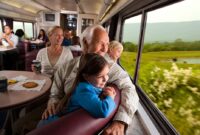Day trips for seniors offer a fantastic opportunity to explore new places, engage in enriching activities, and create lasting memories. This guide delves into the essential aspects of planning memorable and accessible day trips tailored specifically for the needs and preferences of older adults. We’ll cover everything from choosing the right type of trip and ensuring safe transportation to budgeting effectively and prioritizing health and safety. Whether you’re a senior planning your own adventure or a caregiver assisting a loved one, this comprehensive resource provides valuable insights and practical tips to make your next day trip a resounding success.
We explore diverse trip options, ranging from low-impact garden visits to moderate-intensity museum tours and even more active excursions, considering accessibility features and transportation options for each. The guide also provides essential safety advice, budgeting strategies, and resources to help you find accessible and enjoyable day trips that cater to various physical abilities and interests. We emphasize the importance of careful planning and inclusive considerations to ensure a positive and memorable experience for all seniors.
Types of Day Trips
Choosing the right day trip is crucial for ensuring a safe and enjoyable experience for seniors. Consideration should be given to the individual’s physical capabilities, interests, and preferred pace. A well-planned day trip can provide valuable social interaction, mental stimulation, and a welcome change of scenery.
Day Trip Options Categorized by Activity Level and Accessibility
The following table outlines ten diverse day trip options suitable for seniors, categorized by activity level and detailing accessibility features. Remember to always check accessibility specifics with the chosen location before your trip.
| Trip Type | Activity Level | Accessibility Features | Example Location |
|---|---|---|---|
| Scenic Drive/Tour | Low | Accessible vehicles available from many tour operators; minimal walking required. Consider tours with restroom breaks and adjustable seating. | Coastal Highway drive with ocean views |
| Botanical Garden Visit | Low to Moderate | Many gardens offer paved pathways, wheelchairs, and accessible restrooms. Check for gradient information beforehand; some gardens may have hilly sections. | Local botanical gardens with paved paths |
| Museum Visit | Low to Moderate | Most museums offer wheelchair access, elevators, and accessible restrooms. Check the museum website for specific accessibility information. Consider booking a wheelchair in advance. | Art museum with ramp access and elevators |
| Historical Site Tour (Guided) | Low to Moderate | Choose guided tours that offer appropriate pacing and rest stops. Confirm wheelchair accessibility and the availability of assistive listening devices. | Historic house museum with audio guides and ramp access |
| Lunch Cruise | Low | Most cruise ships offer wheelchair access and accessible restrooms. Check for ramps and elevator availability. Consider booking a table near the exit for easy access. | Riverboat lunch cruise with elevator access |
| Wine Tasting (Small Winery) | Low to Moderate | Smaller wineries often have more accessible facilities than larger ones. Check for paved pathways and accessible restrooms. Consider contacting the winery beforehand. | Local vineyard with accessible tasting room |
| Relaxing Spa Day | Low | Choose a spa that offers accessible facilities and treatments suitable for seniors. Confirm wheelchair access and availability of specialized services. | Spa with accessible changing rooms and treatment rooms |
| Antique Shopping | Moderate | Accessibility varies widely depending on the shop. Choose shops with single-story layouts and wide aisles. Be aware of potential uneven flooring. | Antique mall with wide aisles and level entry |
| Gentle Walking Tour (Nature Trail) | Moderate | Choose trails with paved or well-maintained surfaces. Look for trails with minimal elevation changes and benches for rest stops. Consider using walking sticks for added support. | Nature trail with paved path and benches |
| Cooking Class (Small Group) | Low to Moderate | Ensure the venue is accessible and the class is structured to accommodate different mobility levels. Contact the instructor to discuss any specific needs. | Cooking school with accessible kitchen and seating |
Accessibility and Inclusivity
Planning accessible and inclusive day trips for seniors requires careful consideration of potential barriers and proactive solutions. Ensuring everyone can participate comfortably and safely is paramount to creating a positive and memorable experience. This section outlines key considerations for accessibility and inclusivity in senior day trip planning.
Potential Accessibility Barriers and Solutions
Several factors can hinder seniors’ participation in day trips. These barriers may be physical, cognitive, or sensory in nature. Addressing these proactively ensures a more enjoyable and inclusive experience for all participants.
- Transportation: Limited mobility can make accessing transportation challenging. Solutions include arranging accessible transportation options such as wheelchair-accessible vans or providing clear instructions for using public transport with step-free access. Pre-booking transportation is crucial to guarantee availability.
- Walking Distances and Terrain: Long distances and uneven terrain can be difficult for seniors with mobility issues. Solutions involve choosing locations with shorter walking distances, providing rest stops along the way, and opting for routes with paved, level surfaces. Offering the option of alternative transportation within the day trip location (golf carts, etc.) can also be beneficial.
- Building Accessibility: Many historical sites or attractions lack wheelchair ramps, elevators, or accessible restrooms. Pre-trip research is essential to identify accessible venues and plan accordingly. Contacting venues in advance to confirm accessibility features and make arrangements for any necessary assistance is recommended.
- Sensory Considerations: Loud noises, bright lights, and crowded spaces can be overwhelming for some seniors. Solutions involve choosing less crowded locations and times, providing earplugs or noise-canceling headphones if necessary, and planning for breaks in quieter environments.
- Cognitive Considerations: Cognitive impairments can affect participation. Solutions include providing clear and concise instructions, using visual aids, and maintaining a slower pace. Offering simplified itineraries and avoiding overly complex activities can improve comprehension and engagement.
Adapting Itineraries for Diverse Needs
Adapting itineraries is key to ensuring everyone can participate comfortably. This involves considering individual needs and preferences.
Pace: Incorporate frequent rest stops and allow ample time for activities. Avoid rushing and offer flexibility in the schedule. A slower pace allows seniors to enjoy the experience without feeling pressured.
Seating: Ensure sufficient seating is available throughout the day trip, including on transportation and at various locations. Consider providing comfortable seating options, such as chairs or benches, at rest stops and scenic viewpoints.
Restroom Access: Plan for regular restroom breaks and ensure easy access to clean, accessible restrooms. Identify restroom locations in advance and include them in the itinerary. Confirm accessibility features before the trip.
Resources for Accessible Day Trips
Finding accessible day trip options can be simplified by utilizing various resources. These resources provide information on accessible venues, transportation, and services.
- Local Tourism Boards: Many tourism boards offer information on accessible attractions and services within their region. Contacting them directly can provide valuable insights and personalized recommendations.
- Accessibility Websites and Apps: Several websites and mobile applications specialize in providing accessibility information for various locations and services. These tools can help you identify accessible routes, venues, and transportation options.
- Senior Centers and Organizations: Local senior centers and organizations often offer information on accessible day trips and related services. They can connect seniors with suitable options and provide support for planning.
Health and Safety
Participating in day trips offers numerous benefits for seniors, but prioritizing health and safety is paramount. A well-planned trip, coupled with necessary precautions, ensures a positive and enjoyable experience for all participants. This section details important considerations to guarantee the well-being of seniors throughout the day.
Ensuring the health and safety of seniors on day trips requires a multi-faceted approach, encompassing pre-trip planning, appropriate supervision during the trip, and preparedness for unforeseen circumstances. This includes understanding individual health needs, environmental factors, and potential risks. Communication and clear expectations are key to a successful and safe outing.
Essential Medical Information and Medications
Before embarking on a day trip, it is crucial to gather and readily access each senior’s relevant medical information. This includes a list of current medications, allergies, existing medical conditions (such as diabetes, heart conditions, or mobility issues), and emergency contact information. This information should be carried by the senior or a designated companion, ideally in a clearly marked and easily accessible location. A copy should also be provided to the trip organizer.
Emergency Procedures
A comprehensive emergency plan should be in place before the day trip commences. This includes identifying potential hazards, establishing clear communication protocols, and designating a responsible individual to handle emergencies. The plan should specify the procedures to follow in case of a medical emergency, such as calling emergency services, administering first aid, or transporting a participant to a medical facility. Participants should be briefed on the emergency plan before departure. Knowing the location of the nearest hospital or medical clinic is also crucial.
Checklist of Essential Items
Prior to the day trip, seniors should prepare a checklist of essential items to ensure their comfort and safety. This checklist should be personalized to individual needs and the planned activities.
- Medications: A sufficient supply of all prescribed medications, clearly labeled and in their original containers.
- Personal Healthcare Items: Any necessary personal care items, such as glasses, hearing aids, mobility aids (canes, walkers), and any other assistive devices.
- Identification: Photo identification and any necessary medical identification cards.
- Emergency Contact Information: A list of emergency contacts, including family members, doctors, and the trip organizer.
- Water Bottle: Staying hydrated is crucial, especially during warmer weather.
- Snacks: Non-perishable snacks to prevent hunger-related discomfort.
- Comfortable Clothing and Footwear: Appropriate attire for the weather and planned activities, including comfortable shoes.
- Sunscreen and Hat: Protection from the sun’s harmful rays.
- First-Aid Kit (Personal): A small personal first-aid kit containing bandages, antiseptic wipes, and pain relievers.
The Role of Companions or Caregivers
Companions or caregivers play a vital role in ensuring the safety and comfort of seniors during day trips. Their responsibilities include: monitoring the senior’s health and well-being throughout the day; assisting with mobility and personal care needs; administering medications as needed; and ensuring the senior remains hydrated and nourished. They should also be aware of the emergency plan and be prepared to assist in case of an emergency. The companion’s presence offers reassurance and peace of mind for both the senior and the trip organizer. A good companion will also be observant of the senior’s physical and emotional state, adjusting the pace and activities as needed.
Epilogue
Planning a successful day trip for seniors involves careful consideration of several key factors, from choosing the right activity level and ensuring accessible transportation to prioritizing health and safety. By following the guidelines and suggestions outlined in this guide, you can create a truly enriching and memorable experience for yourself or your loved ones. Remember that thoughtful planning, a focus on accessibility, and attention to detail can transform a simple day trip into an unforgettable adventure, fostering independence, joy, and lasting memories for seniors.




